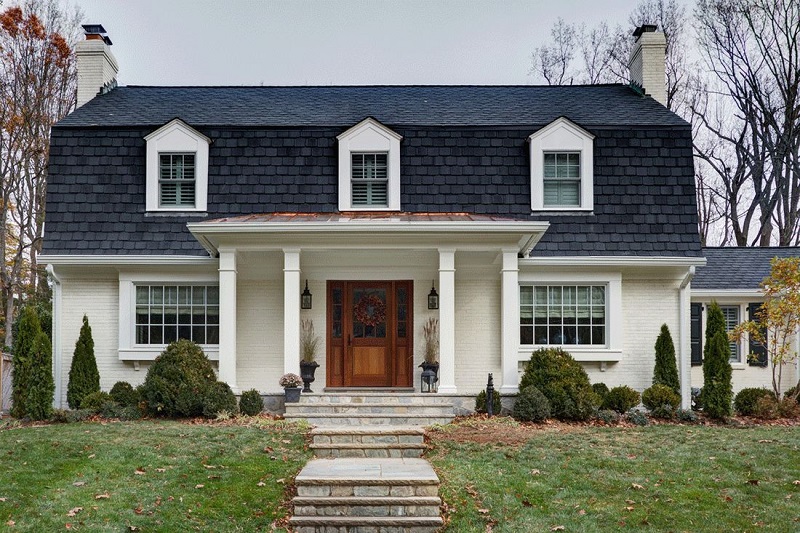Mansard roof
A mansard roof, also known as a French or curb roof, is a roof characterised by that fact that each of its four sides has two pitches, the lower pitches being steeper than the upper pitches. It is similar to a gambrel roof but differs in that it displays the same profile on all sides (whereas a gambrel roof has vertical gables at either end). The lower slope is commonly fitted with dormer windows.
Mansard roofs allow for increased space beneath their steeper sides. They maximise headroom inside the upper storey of the building whilst lowering, what would if it were simply-pitched, be a very tall roof. The mansard form can also help water runoff, as the pitch increases towards the eaves, where the runoff is likely to be at its greatest.
When viewed from near the building at ground level, the upper slope is often not visible.
The commonly-attributed earliest example of a mansard roof is the Louvre, designed by Pierre Lescot around 1550. It was popularised in the French Baroque period by Francois Mansart and became widely used during the Second French Empire (1852-1870) as well as in the United States and Europe. One of the factors attributable for its popularity in France was that houses were taxed by height or the number of storeys below the roof. The design of the mansard enabled the creation of an additional floor without having to pay additional tax.
NB The National Planning Policy Framework (NPPF), published by the Ministry of Housing, Communities and Local Government in December 2024, defines a mansard roof as: ‘A type of roof that is characterised by two slopes, the lower steep and the upper shallow. It is generally regarded as a suitable type of roof extension for buildings which are part of a terrace of at least three buildings and at least two stories tall, with a parapet running the entire length of the front façade (reference: Create Streets, 2021, Living Tradition).’
[edit] Related articles on Designing Buildings
Featured articles and news
CIOB report; a blueprint for SDGs and the built environment
Pairing the Sustainable Development Goals with projects.
Latest Build UK Building Safety Regime explainer published
Key elements in one short, now updated document.
UKGBC launch the UK Climate Resilience Roadmap
First guidance of its kind on direct climate impacts for the built environment and how it can adapt.
CLC Health, Safety and Wellbeing Strategy 2025
Launched by the Minister for Industry to look at fatalities on site, improving mental health and other issues.
One of the most impressive Victorian architects. Book review.
Common Assessment Standard now with building safety
New CAS update now includes mandatory building safety questions.
RTPI leader to become new CIOB Chief Executive Officer
Dr Victoria Hills MRTPI, FICE to take over after Caroline Gumble’s departure.
Social and affordable housing, a long term plan for delivery
The “Delivering a Decade of Renewal for Social and Affordable Housing” strategy sets out future path.
A change to adoptive architecture
Effects of global weather warming on architectural detailing, material choice and human interaction.
The proposed publicly owned and backed subsidiary of Homes England, to facilitate new homes.
How big is the problem and what can we do to mitigate the effects?
Overheating guidance and tools for building designers
A number of cool guides to help with the heat.
The UK's Modern Industrial Strategy: A 10 year plan
Previous consultation criticism, current key elements and general support with some persisting reservations.
Building Safety Regulator reforms
New roles, new staff and a new fast track service pave the way for a single construction regulator.
Architectural Technologist CPDs and Communications
CIAT CPD… and how you can do it!
Cooling centres and cool spaces
Managing extreme heat in cities by directing the public to places for heat stress relief and water sources.
Winter gardens: A brief history and warm variations
Extending the season with glass in different forms and terms.
Restoring Great Yarmouth's Winter Gardens
Transforming one of the least sustainable constructions imaginable.

























Comments
I love this design!!! I have a home with a mansard roof and I am trying to renovate the front. I am wondering if you know the dimensions of the two windows on each side of the door?